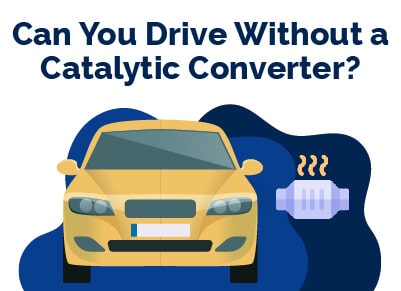Can You Drive Without a Catalytic Converter?
February 7, 2023


I am a serial entrepreneur and a consumer advocate. When I’m not helping car buyers, I love working on ventures that have a positive impact.
I run a cause marketing agency and serve on the board of Vayu Global Health where we are disrupting the medical industry and preventing the needless deaths of mothers and babies during childbirth.
Driving without a catalytic converter? It's important to know that this part is crucial for reducing your vehicle's emissions and meeting legal environmental standards.
In this post, we'll cover whether you can legally drive without one, how it impacts your car's performance, and the environmental consequences.
We'll give you the straightforward facts about the necessity of catalytic converters and what to consider if you're thinking about removing or if you're missing one.
Let's get started.
Table of Contents
- What Is a Catalytic Converter?
- What Does a Catalytic Converter Do?
- Is a Catalytic Converter Really Necessary?
- Can You Drive Without a Catalytic Converter?
- How Long Can You Drive Without a Catalytic Converter?
- Is It Safe to Drive Without a Catalytic Converter?
- Symptoms of a Bad Catalytic Converter
- Can You Replace a Catalytic Converter With a Straight Pipe?
- Best Car Deals by Category
What Is a Catalytic Converter?
The catalytic converter is an exhaust emissions control device that is an essential component of most vehicles' exhaust systems. It was first introduced in the 1970s and quickly became standard equipment.
There are many laws in place today that make removing, modifying, or intentionally damaging the catalytic converter illegal.
What Does a Catalytic Converter Do?
A catalytic converter uses precious metals to convert toxic substances created by the combustion in an engine into safer ones (water vapor) by triggering chemical reactions.
Is a Catalytic Converter Really Necessary?
Yes, in most cases a catalytic converter is necessary for proper vehicle function.
If the vehicle's exhaust and engine are modified or designed to operate without a catalytic converter, it is unnecessary to have one.
In terms of global vehicle emissions, the catalytic converter is a vital component that car manufacturers use to improve the car’s performance and reduce harm to the environment.
Can You Drive Without a Catalytic Converter?
You can technically drive without a catalytic converter for a short period of time, but driving it around for longer than that could lead to engine damage and possible legal consequences.
Driving around without a catalytic converter could cause issues with your vehicle, such as a lack of power and poor performance.
Removing the rear or front catalyst is illegal in every state and will also cause a vehicle to fail emissions tests in certain states, such as California, where emissions testing is required.
How Long Can You Drive Without a Catalytic Converter?
It is not recommended to drive any distance without a catalytic converter since it is illegal and can reduce cas mileage, but you can drive for a short amount of time before getting a new one.
In non-emission testing areas, vehicles without a catalytic converter can be operated. However, removing a cat-con in every state is illegal, even those that don't enforce emissions standards.
Is It Safe to Drive Without a Catalytic Converter?
Though it can lead to reduced gas mileage and performance, it is generally still safe to drive without a catalytic converter.
Although safety is not a concern if the converter is missing or failing, you should replace it immediately as, once again, it is illegal to drive without one.
If your converter fails, your vehicle's tailpipe emissions will increase, which could be harmful to the environment.
Symptoms of a Bad Catalytic Converter
Some warning signs of a bad catalytic converter include a lack of acceleration, an illuminated check engine light, or a vehicle that won't start. The only sign of a failed converter is an illuminated check engine light.
In certain cases, a catalytic converter may become restricted or blocked, which can cause various issues such as hard starting, stalling, and lack of acceleration.
Can You Replace a Catalytic Converter With a Straight Pipe?
If you are okay with breaking the law, yes, you technically can replace a catalytic converter with a straight pipe.
However, you will still fail emmissions tests.
Best Car Deals by Category
Posted in Car Buying Tips, Car Troubleshooting |




